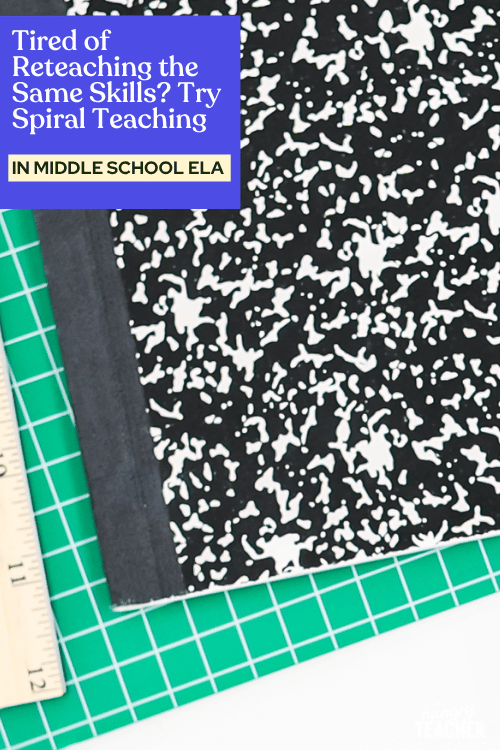hey friend!
I'm Martina.
I provide practical, time-saving strategies that actually work—so you can engage your students, teach effectively, and reclaim your time from the exhausting planning-grading cycle.
Browse Our ELA Resources
Tired of Reteaching the Same Skills? Try Spiral Teaching
You look back at the school year, and you’re proud that you hit all your standards. But something still feels…incomplete. Sure, students can tell you what a simile is or locate the main idea in a text, but the depth of knowledge isn’t there. You feel like you spent the whole year reteaching skills and skimming the surface, instead of digging deep into each standard. Before I learned about spiral teaching, my lessons felt disjointed and often stuck to the surface. But with a spiral curriculum in hand, my students ended the school year with a much deeper understanding of each skill.

What is a Spiral Curriculum?
The concept is pretty simple. A spiral curriculum is when skills and standards are revisited throughout a curriculum, and the complexity increases over time. That means instead of just reteaching main idea each time it comes up, you take it a step further. You challenge students and get them to analyze and think critically about the main idea. The strategy is that by increasing the complexity, you’re increasing the depth of knowledge, which means students can truly master the skill. (Wondering what a spiral curriculum looks like? Check out my ELA spiral curriculum, Masterful Mentor Text Curriculum.)
Spiral teaching is how you challenge students throughout the curriculum. Again, instead of covering the basics or reteaching the skill each time it comes up, you challenge students’ knowledge.
What is an Example of Spiral Learning?
A lot of times, spiral curriculum is mentioned with math because it’s easy to see the progression of skills. Obviously, students need to understand how to add one-digit numbers before they can add two-digit numbers. But spiral teaching can be used in the ELA classroom, too.
Let’s think about it with figurative language. At the beginning of a spiral curriculum, you’re going to teach and introduce the basics of figurative language. You’ll probably share examples and definitions, and you might have students look for examples inside a text. In your next lesson, however, things have to go deeper. This time, when students identify an example in a text, you might ask them to analyze what it means. To go even further, figurative language can be reintroduced during a writing unit. This is where students have to create their own examples.
That is spiral teaching. Sure, you can revisit definitions and examples to keep knowledge fresh, but you can’t stop there. You have to increase the complexity or rigor. It’s like climbing the Bloom’s Taxonomy ladder: you start with remembering, and you move up toward analyzing, evaluating, and creating as you spiral the skills.

Spiral Teaching in Middle School ELA
If you’re on board with spiral teaching, but aren’t sure how to implement it or how to progress from one level to the next, that’s okay. It’s not something they usually teach in a PD course or even college classes. But the good news is that you don’t have to figure it out alone. I have a few strategies and resources that can help you dive in.
#1 Alternating Units
The first step to implementing spiral teaching is switching to alternating units. Usually in an ELA classroom, teachers try to fit all the skills into a class period. Not only is that headache-inducing, but it doesn’t allow you to dig deep into the skills. You’re always stuck skimming the surface because time is limited. AKA it’s impossible to spiral skills.
With alternating units, you focus on reading or writing skills during each unit. This means for several weeks, you can get into the nitty gritty of reading or writing. You’re not ditching other skills during this time. It’s just not your focus.
For example, you might start the year with a nonfiction reading unit. During that unit, students are reading a nonfiction novel in their book clubs and answering short response questions (that’s the writing piece woven in). After you wrap up that unit, you move to an expository writing unit. Now, your focus is on writing skills, and you use their book club novel as a mentor text to model the type of writing.
I talk about alternating units way more in-depth inside my Curriculum Carousel Workshop, which all Hungry Teacher’s Hub members have free access to. I share how to get started with alternating units, how to scaffold lessons throughout each unit, and how to teach all the standards without feeling short on time.
#2 Creating a Pacing Guide
Once you’ve made the switch to alternating units, you’ll want to create a pacing guide. This will be the backbone of your spiral curriculum. It will outline the order you’ll teach each unit. This makes it a lot easier to implement spiral teaching.
For example, if you put your realistic fiction unit before your narrative writing unit, you can figure out how to spiral and deepen the skills. In the realistic fiction unit, you’ll need to introduce and build the foundation for lots of concepts, like characters, plot, motivation, etc. Then, when your narrative writing unit comes around, you’ll spiral those skills and take them deeper. Now, students need to create their own characters and design their own plot.
You can grab my free middle school ELA scope and sequences to begin mapping out your pacing guide. This pacing guide follows my spiral curriculum plans, so I’ve placed units in order that helps me spiral with ease, but you can edit the order to fit your classroom.

#3 Using a Spiral Curriculum
Of course, the easiest way to implement spiral teaching is to use a curriculum that spirals the skills for you. With my Masterful Mentor Text Curriculum, I’ve done the work of alternating units, laying out your pacing guide, and spiraling the skills. All you have to do is teach!
The Masterful Mentor Text Curriculum includes daily lesson plans that break down the concepts and help students build their knowledge. No more repetition or staying stuck at the surface. As you move through the curriculum, students will move deeper into the skills and increase their reading, writing, and grammar proficiency.
This curriculum includes six reading units, five writing units, a year-long grammar curriculum, and all the resources and activities you need. Plus, you’ll get novel study coupons, so you can select the mentor texts to use inside the curriculum (there are over 35 novels to choose from).

Want a sneak peek at teaching The Hungry Teacher way—with support, structure, and strategy?
When you join the waitlist for The Hungry Teacher’s Hub membership, you get three free classroom-ready resources: a theme unit, an expository writing unit, and a grammar unit introducing mentor sentences. Plus, you’ll get immediate access to a selection of exclusives from the Hub, including editable sub plans, pacing guides, and more.
No strings attached. Just resources you can use right now—and a heads-up when the Hub opens.
3 Free Middle School ELA Units—yours to keep!
JOIN THE WAITLIST + A FREE GIFT
Where to next, line leader?
Welcome to The Hungry Teacher! We create resources that are easy to use, practical, and get results. Teach with confidence—and make it home before dinner.
xo, the hungry teacher